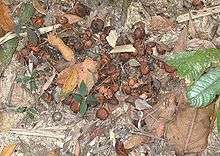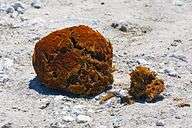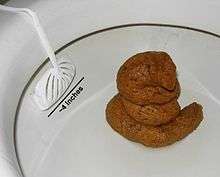Feces
Feces or faeces are the solid or semisolid metabolic waste from an animal's digestive tract, discharged through the anus or cloaca during a process called defecation. Urine and feces together are called excreta.
Collected feces has various uses, namely as fertilizer or soil conditioner in agriculture, as a fuel source, or for medicinal purposes (fecal transplants or fecal bacteriotherapy, in the case of human feces).
Ecology


After an animal has digested eaten material, the remains of that material are discharged from its body as waste. Although it is lower in energy than the food from which it is derived, feces may retain a large amount of energy, often 50% of that of the original food.[1] This means that of all food eaten, a significant amount of energy remains for the decomposers of ecosystems. Many organisms feed on feces, from bacteria to fungi to insects such as dung beetles, who can sense odors from long distances.[2] Some may specialize in feces, while others may eat other foods as well. Feces serve not only as a basic food, but also as a supplement to the usual diet of some animals. This is known as coprophagia, and occurs in various animal species such as young elephants eating the feces of their mothers in order to gain essential gut flora, or by other animals such as dogs, rabbits, and monkeys.
Feces and urine, which reflect ultraviolet light, are important to raptors such as kestrels, who can see the near ultraviolet and thus find their prey by their middens and territorial markers.[3]
Seeds also may be found in feces. Animals who eat fruit are known as frugivores. An advantage for a plant in having fruit is that animals will eat the fruit and unknowingly disperse the seed in doing so. This mode of seed dispersal is highly successful, as seeds dispersed around the base of a plant are unlikely to succeed and often are subject to heavy predation. Provided the seed can withstand the pathway through the digestive system, it is not only likely to be far away from the parent plant, but is even provided with its own fertilizer.
Organisms that subsist on dead organic matter or detritus are known as detritivores, and play an important role in ecosystems by recycling organic matter back into a simpler form that plants and other autotrophs may absorb once again. This cycling of matter is known as the biogeochemical cycle. To maintain nutrients in soil it is therefore important that feces return to the area from which they came, which is not always the case in human society where food may be transported from rural areas to urban populations and then feces disposed of into a river or sea.
Characteristics

The distinctive odor of feces is due to bacterial action. Gut flora produce compounds such as indole, skatole, and thiols (sulfur-containing compounds), as well as the inorganic gas hydrogen sulfide. These are the same compounds that are responsible for the odor of flatulence. Consumption of foods prepared with spices may result in the spices being undigested and adding to the odor of feces.
The perceived bad odor of feces has been hypothesized to be a deterrent for humans, as consuming or touching it may result in sickness or infection.[4] Human perception of the odor may be contrasted by a non-human animal's perception of it; for example, an animal who eats feces may be attracted to its odor.
Human feces
In humans and depending on the individual and the circumstances, defecation may occur daily, or once every two or three days to several times a day. Extensive hardening of the feces may cause prolonged interruption in the routine and is called constipation.
Human fecal matter varies significantly in appearance, depending on diet and health.[5] Normally it is semisolid, with a mucus coating. The brown coloration comes from a combination of bile and bilirubin, which comes from dead red blood cells.
In newborn babies, initially fecal matter is yellow-green after the meconium. This coloration comes from the presence of bile alone. In time, as the body starts expelling bilirubin from dead red blood cells, it acquires its familiar brown appearance, unless the baby is breast feeding, in which case it remains soft, pale yellowish, and not completely malodorous, until the baby begins to eat significant amounts of other food.
Throughout the life of an ordinary human, one may experience many types of feces. A "green" stool is from rapid transit of feces through the intestines (or the consumption of certain blue or green food dyes in quantity), and "clay-like" appearance to the feces is the result of a lack of bilirubin.
Pets

Pets can be trained to use litter boxes or wait to be allowed outside to defecate. Training can be done in several ways, especially dependent on species. An example is crate training for dogs. Several companies market cleaning products for pet owners whose pets have soiled carpets in the home.
Uses
Manure, fertilizer, and special products
The feces of animals often are used as fertilizer; see guano and manure. In northern Thailand, elephants are used to digest coffee beans in order to make Black Ivory coffee, which is among the world's most expensive coffees.[6] Human feces also may be used as fertilizer (reuse of excreta in agriculture), and it has been known as night soil.
Energy source
Dry animal dung is used as a fuel source in many countries around the world by burning it. Some animal feces, especially those of camel, bison, and cattle, are used as fuel when dried.[7]
Animals such as the giant panda[8] and zebra[9] possess gut bacteria capable of producing biofuel. The bacteria, Brocadia anammoxidans, can create the rocket fuel hydrazine from feces.[10][11]
The biogas produced from feces when it is contained in sewage and treated in an anaerobic digestion process could be worth as much as 9.5 billion dollars.[12]
Washington DC plans to produce biogas from sewage sludge, the by-product of sewage treatment, which will save 13 million dollars a year.[13]
Fecal transplant, gut flora transplant
In humans, fecal transplants (or stool transplant) is the process of transplantation of fecal bacteria from a healthy individual into a recipient who is suffering from a certain disease, such as irritable bowel syndrome. The resulting inoculation of healthy gut flora can sometimes improve the physiology of the recipient gut.
Fecal bacteriotherapy—also known as a fecal transplant—is a medical procedure wherein fecal bacteria are transplanted from a healthy individual into a patient.[14][15] Recent research indicates that this may be a valuable method to re-establish normal gut cultures that have been destroyed through the use of antibiotics or some other medical treatments.
Elephants, hippos, koalas and pandas are born with sterile intestines, and require bacteria obtained from eating the feces of their mothers to digest vegetation.
Coprolites and paleofeces
A coprolite is fossilized feces and is classified as a trace fossil. In paleontology they give evidence about the diet of an animal. They were first described by William Buckland in 1829. Prior to this they were known as "fossil fir cones" and "bezoar stones". They serve a valuable purpose in paleontology because they provide direct evidence of the predation and diet of extinct organisms.[16] Coprolites may range in size from a few millimetres to more than 60 centimetres.
Paleofeces are ancient human feces, often found as part of archaeological excavations or surveys. Intact feces of ancient people may be found in caves in arid climates and in other locations with suitable preservation conditions. These are studied to determine the diet and health of the people who produced them through the analysis of seeds, small bones, and parasite eggs found inside. These feces may contain information about the person excreting the material as well as information about the material. They also may be analyzed chemically for more in-depth information on the individual who excreted them, using lipid analysis and ancient DNA analysis. The success rate of usable DNA extraction is relatively high in paleofeces, making it more reliable than skeletal DNA retrieval.[17]
The reason this analysis is possible at all is due to the digestive system not being entirely efficient, in the sense that not everything that passes through the digestive system is destroyed. Not all of the surviving material is recognizable, but some of it is. Generally, this material is the best indicator archaeologists can use to determine ancient diets, as no other part of the archaeological record is so direct an indicator.[18]
A process that preserves feces in a way that they may be analyzed later is called the Maillard reaction. This reaction creates a casing of sugar that preserves the feces from the elements. To extract and analyze the information contained within, researchers generally have to freeze the feces and grind it up into powder for analysis.[19]
Other uses

Animal dung occasionally is used as a cement to make adobe mudbrick huts,[20] or even in throwing sports such as cow pat throwing or camel dung throwing contests.[21]
Kopi Luwak (pronounced [ˈkopi ˈlu.aʔ]), or civet coffee, is coffee made from coffee berries that have been eaten by and passed through the digestive tract of the Asian palm civet (Paradoxurus hermaphroditus). Giant pandas provide fertilizer for the world's most expensive green tea.[6] In Malaysia, tea is made from the droppings of stick insects fed on guava leaves.
Dog feces were used in the tanning process of leather during the Victorian era. Collected dog feces, known as "pure", "puer", or "pewer",[22] were mixed with water to form a substance known as "bate." Enzymes in the dog feces helped to relax the fibrous structure of the hide before the final stages of tanning.[23]
A Japanese sewage treatment facility mines the sewers for metals. This idea was also tested by the US Geological Survey (USGS) which found the sewage generated by 1 million people contained 13 million dollars worth of precious metals.[24][25]
Society and culture
Feelings of disgust
In all human cultures, feces elicit varying degrees of disgust, a basic human emotion. Disgust is experienced primarily in relation to the sense of taste (either perceived or imagined) and, secondarily to anything that causes a similar feeling by sense of smell, touch, or vision. As such, human feces is regarded as something to be avoided diligently: expelled in private and disposed of immediately and without a trace. It often is considered an unacceptable topic in polite conversation and its mere mention may cause offence in certain contexts. An example from the ancient world of repulsion by feces is found in Deuteronomy 23:12-14.
12Designate a place outside the camp where you can go to relieve yourself. 13 As part of your equipment have something to dig with, and when you relieve yourself, dig a hole and cover up your excrement. 14 For the LORD your God moves about in your camp to protect you and to deliver your enemies to you. Your camp must be holy, so that he will not see among you anything indecent and turn away from you.[26]
The disposal of feces always has been associated with the lowest people among a society, the social outcasts, the pariahs, and the social discards. The caste system in India was created along the lines of profession and the dalits (untouchables) were left to do work related to human emissions. They did such work as cleaning and picking feces from streets, cleaning toilets, and working with dead bodies. Such practices are prevalent even today in the rural and small villages of India; where it is called "manual scavenging".
Etymology
The word faeces is the plural of the Latin word faex meaning "dregs". In most English-language usage, there is no singular form, making the word a plurale tantum;[27] out of various major dictionaries, only one enters variation from plural agreement.[28]
Synonyms
"Feces" is used more in biology and medicine than in other fields (reflecting science's tradition of classical Latin and New Latin)
- In hunting and tracking, terms such as dung, scat, spoor, and droppings normally are used to refer to non-human animal feces
- In husbandry and farming, manure is common.
- Stool is a common term in reference to human feces. For example, in medicine, to diagnose the presence or absence of a medical condition, a stool sample sometimes is requested for testing purposes.[29]
- The term bowel movement(s) (with each movement a defecation event) is also common in health care.
As with urine, there are many synonyms in informal registers for feces. Many are euphemismistic, colloquial, or both; some are profane (such as shit), whereas most belong chiefly to child-directed speech (such as poo or poop) or to crude humor (such as deuce or turd). It is also represented in emoji form in the Miscellaneous Symbols and Pictographs block of Unicode as U+1F4A9 💩 PILE OF POO, called unchi or unhci-kun in Japan.[30][31]

The feces of animals often have special names, for example:
- Non-human animals
- As bulk material – dung
- Individually – droppings
- Cattle
- Bulk material – cow dung
- Individual droppings – cow pats, meadow muffins, etc.
- Deer (and formerly other quarry animals) – fewmets
- Wild carnivores – scat
- Otter – spraint
- Birds (individual) – droppings (also include urine as white crystals of uric acid)
- Seabirds or bats (large accumulations) – guano
- Herbivorous insects, such as caterpillars and leaf beetles – frass
- Earthworms, lugworms etc. – worm castings (feces extruded at ground surface)
- Feces when used as fertilizer (usually mixed with animal bedding and urine) – manure
- Horses – horse manure, roadapple (before motor vehicles became common, horse droppings were a big part of the rubbish communities needed to clean off roads)
See also
References
- ↑ Biology (4th edition) N.A.Campbell (Benjamin Cummings NY, 1996) ISBN 0-8053-1957-3
- ↑ Heinrich B, Bartholomew GA (1979). "The ecology of the African dung beetle". Scientific American. 241 (5): 146–56. doi:10.1038/scientificamerican1179-146.
- ↑ "Document: Krestel". City of Manhattan, Kansas. Retrieved 11 February 2012.
- ↑ Curtis V, Aunger R, Rabie T (May 2004). "Evidence that disgust evolved to protect from risk of disease". Proc. Biol. Sci. 271 Suppl 4 (Suppl 4): S131–3. doi:10.1098/rsbl.2003.0144. PMC 1810028
 . PMID 15252963.
. PMID 15252963. - ↑ Stromberg, Joseph, ...Nine surprising facts about feces..., Vox, Friday, January 23, 2015
- 1 2 Topper, R (15 October 2012). "Elephant Dung Coffee: World's Most Expensive Brew Is Made With Pooped-Out Beans". The Huffington Post. Retrieved 10 December 2012.
- ↑ "Dried Camel Dung as fuel".
- ↑ "Panda Poop Might Help Turn Plants Into Fuel". News.nationalgeographic.com. 2013-09-10. Retrieved 2013-10-02.
- ↑ Kathryn Hobgood Ray (August 25, 2011). "Cars Could Run on Recycled Newspaper, Tulane Scientists Say". Tulane University news webpage. Tulane University. Retrieved March 14, 2012.
- ↑ Bacteria Eat Human Sewage, Produce Rocket Fuel
- ↑ Hydrazine Synthase, a Unique Phylomarker with Which To Study the Presence and Biodiversity of Anammox Bacteria
- ↑ "Will the Future Be Powered by Feces? : DNews". DNews. Retrieved 2016-02-27.
- ↑ Shaver, Katherine (2015-10-07). "D.C. Water begins harnessing electricity from every flush". The Washington Post. ISSN 0190-8286. Retrieved 2016-02-27.
- ↑ Rowan, Karen (20 October 2012). "'Poop Transplants' May Combat Bacterial Infections". LiveScience.com. Retrieved 2012-10-20.
- ↑ Bakken, Johan S.; Borody, Thomas; Brandt, Lawrence J.; Brill, Joel V.; Demarco, Daniel C.; Franzos, Marc Alaric; Kelly, Colleen; Khoruts, Alexander; Louie, Thomas; Martinelli, Lawrence P.; Moore, Thomas A.; Russell, George; Surawicz, Christina (1 December 2011). "Treating Clostridium difficile Infection With Fecal Microbiota Transplantation". Clinical Gastroenterology and Hepatology. 9 (12): 1044–1049. doi:10.1016/j.cgh.2011.08.014. PMC 3223289
 . PMID 21871249.
. PMID 21871249. - ↑ "coprolites - Definitions from Dictionary.com".
- ↑ Poinar, Hendrik N.; et al. (10 April 2001). "A Molecular Analysis of Dietary Diversity for Three Archaic Native Americans". PNAS. 98 (8): 4317–4322. doi:10.1073/pnas.061014798. PMC 31832
 . PMID 11296282.
. PMID 11296282. - ↑ Feder, Kenneth L., Linking to the Past: A Brief Introduction to Archaeology. New York: Oxford University Press, 2008. Print.
- ↑ Stokstad, Erik (28 July 2000). "Divining Diet and Disease From DNA". Science. 289 (5479): 530–531. doi:10.1126/science.289.5479.530.
- ↑ "Your Home Technical Manual – 3.4d Construction Systems – Mud Brick (Adobe)". Archived from the original on 2007-07-06. Retrieved 2007-07-09.
- ↑ "Dung Throwing contests". Archived from the original on October 11, 2007.
- ↑ "pure". Oxford English Dictionary (3rd ed.). Oxford University Press. September 2005. (Subscription or UK public library membership required.) n., 6
- ↑ "Rohm and Haas Innovation - The Leather Breakthrough". Rohmhaas.com. 1909-09-01. Archived from the original on October 19, 2012. Retrieved 2012-10-27.
- ↑ "Sewage yields more gold than top mines". Reuters. 2009-01-30. Retrieved 2016-02-27.
- ↑ "Feces to fortune: US sewage may contain billions in precious metals". RT International. Retrieved 2016-02-27.
- ↑ Deuteronomy 23:12-14, The Bible, New International Version (NIV)
- ↑ "Feces definition – Medical Dictionary definitions of popular medical terms easily defined on MedTerms". Medterms.com. 2012-03-19. Retrieved 2013-11-11.
- ↑ Houghton Mifflin Harcourt, The American Heritage Dictionary of the English Language, Houghton Mifflin Harcourt.
- ↑ Steven Dowshen, MD (September 2011). "Stool Test: Bacteria Culture". Kidshealth. Retrieved 11 February 2012.
- ↑ "The Oral History Of The Poop Emoji (Or, How Google Brought Poop To America)", Fast Company, November 18, 2014
- ↑ DAMON DARLIN (March 7, 2015), "America Needs Its Own Emojis", The New York Times
External links
| Look up feces or faeces in Wiktionary, the free dictionary. |
| Wikimedia Commons has media related to Feces. |
| Look up feces in Wiktionary, the free dictionary. |

